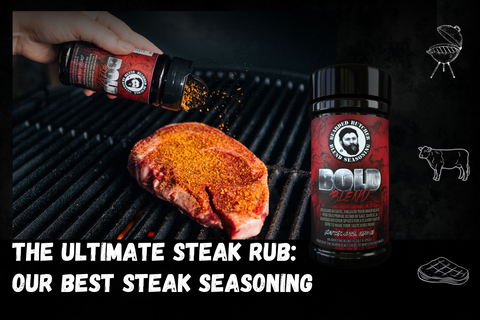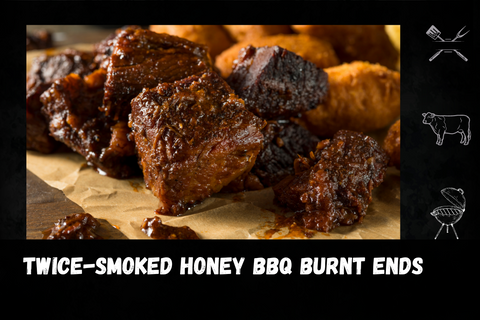The perfect steak rub can take an excellent piece of beef and transform it into a mouthwatering and memorable meal. The trick to getting the perfect steak rub is to find the right balance between salty and savory flavors so that each one mingles with the next to create an intricate and delicious flavor combination. While there are many great flavors to enhance the way your steak will taste, we have a few favorites that we like to share with our family and friends.
How Can I Make My Steak More Flavorful?
There are several ways that you can improve the flavor of your steak, including cooking techniques, preparation methods, and even the way you cut the steak. But the easiest way to improve the flavor of your steak is to use the right spice rub. A spice rub can do more than just add flavor. A good blend can improve the crust, giving your steak a perfectly seared outside while ensuring that the inside of the steak isn't overcooked.
The Best Flavors That Go Well With Steak
A good steak is going to have a deep, meaty flavor all on its own. The goal with flavoring steak is that you don't want to cover up the naturally delicious flavor. Instead, you're trying to enhance and compliment the flavors of the beef. Some flavors will go better with steak than others. We'll start out with some basics and then talk about some less common flavors that will give your steak a unique flavor.
The Basics: Salt and Pepper
Salt and pepper are almost necessary for flavoring steak. Salt enhances the flavors and helps to seal in moisture when the steak cooks. Spicy pepper brings out the robust flavors and compliments the natural flavor of beef probably better than anything else you'll find. You might not believe it, but not all salt and pepper are the same. Some types are better for steak than others.
Salt – Kosher vs Iodized vs Pink Himalayan Salt
Most of our recipes recommend using kosher salt. Kosher salt is a coarse ground, natural salt. It's called "kosher" because of the large size of the crystals that are ideal for drawing moisture out of the meat while preparing kosher meals. It does not contain any additives, unlike regular table salt.
Table salt is a fine-ground salt that has added iodine usually in the form of sodium iodide or potassium iodide. Iodide is added to salt to address the lack of iodine in most diets. It's a key element for proper thyroid function and is often lacking in the American diet. It is also found in seafood, grains, and eggs. Small amounts of iodine are healthy, but larger amounts can cause health problems.
Pink Himalayan Salt is a type of naturally occurring salt that is mined in the mountains of Pakistan. It achieves the delicate pink flavor because of naturally-occurring trace elements and minerals that are present in the regions where the salt is found.
Which Salt is the Best?
We prefer to cook with kosher salt in almost all cases. The larger salt crystals dissolve slower, leaving less chance that meals will be overly salty and it does a fantastic job enhancing flavors. Our second choice is pink Himalayan salt. Like kosher salt, it is typically sold in a coarse grind and does not include added ingredients. We reserve table salt for adding a little saltiness to already cooked foods but try to avoid using it while cooking.
Pepper: Whole vs Cracked vs Ground
Whole peppercorns offer the most robust spiciness and are the go-to choice for giving your meals the best flavor. When peppercorns are stored whole, they lock in the flavors that are only released when you grind them. Freshly ground black pepper will have a better flavor than store-bought, pre-ground pepper. Whole peppercorns are frequently used in stews, soups, roasts, and other dishes.
Cracked black pepper is peppercorns that have not been ground but aren't whole either. These offer a nice blend between the flavor of whole peppercorns and the convenience of ground pepper. Cracked pepper is a good choice for roasts, steaks, and other hearty dishes, but you should pay attention to the size of the peppercorns. Some people are turned off by having large pieces of pepper in their food.
Ground pepper offers the least flavor, but the most convenience. Ground pepper gets used on everything from steaks and pork to potatoes and salad.
Given the choice, you should invest in an inexpensive spice grinder and buy whole peppercorns. They will stay fresh for about six months and offer the most developed flavor. Plus, by cracking or grinding yourself, you'll have control over how fine or coarse you want your pepper.
Black Pepper, Pink Pepper, White Pepper
Black pepper is the most common spice in the world next to salt. The wide availability makes it both economical and convenient to buy. Black pepper has the strongest flavor of any of the types of pepper.
White pepper is made from ripe peppercorns that have the fleshy part of the fruit removed through a process called retting. The white peppercorn has a more subtle flavor and is common in Asian cuisine.
Pink peppercorns are somewhat milder than black pepper and have a softer flavor if that makes sense. An interesting fact: pink peppercorns are not related to black peppercorns. They are different plants altogether but happen to have a similar appearance and flavor. Peppercorns are actually related to cashews. Who knew, right? So don't serve pink peppercorns to people with nut allergies.
Garlic
Garlic is a pungent, edible bulb that is part of the lily family. Garlic is sold whole, minced, and ground. For steak seasonings, we like to use ground or granulated garlic over fresh garlic. It has a more pronounced flavor and sticks to the meat well without burning.
Onion
Onion is another popular and common ingredient for dry rubs to enhance the flavor of steak. Like with garlic, ground or granulated onion is the best choice. Onion powder and garlic powder are both ideal for dry rubs because they stick to the meat and add savory flavor.
Taking the Flavor Up: Spicy Spices
One of the best flavors to complement steak is to add spicy peppers. Ingredients like red pepper flakes (which are crushed red peppers) and paprika (which is a finely ground red pepper) won't make the beef hot and spicy if you use them in moderation, but instead, they enhance the robust and meaty flavor that you love. Smoked paprika is our favorite choice, but it is also available as a mild, hot, or very hot spice.
From the Garden with Love
Another way that you can add depth and dimension to the flavor of your steak is using some of the most common garden herbs. Some of our personal favorites are dill and coriander. You can buy dill fresh, dried, or you can buy the seed, which is sold whole or ground. Our preference is to go with whole dill seed and grind it ourselves. That gives the steak a bright, sweet note without being pungent.
Similarly with coriander, we go for the seed and grind it. Fun fact: coriander and cilantro are the same thing. Cilantro is unbelievably easy to grow in a window sill or a small garden, and then it's available when you want to add some fresh flavor.
Mustard is a plant that grows wild in many parts of the country. You've probably seen it a thousand times even if you didn't know what it was. Mustard is a tall, weedy plant with vibrant yellow flowers. Mustard seed when ground into a powder, adds a tangy, pungent, slightly bitter flavor that enhances the natural savory-sweetness of a well-cooked steak.
What Should I Season My Steak With?
Combining the main ingredients we listed above makes for a delicious, homemade spice mixture that will enhance the flavor of any steak that is cooked on the grill or in a skillet. These flavors mingle very well together and bring out the bold, robust flavors of the beef. But if you're looking for a more convenient method than homemade steak seasoning, we have the perfect blend for you.
Best Steak Seasoning
If you want to get close to homemade steak seasoning without the hassle, our Bearded Butcher Bold Blend Seasoning is just what you've been looking for. It's bold, intense, and perfect for red meat. Sea salt, paprika, celery seed, garlic, and onion powder all come together in this steak seasoning. And as usual, there's no MSG, gluten, or sugar.
How to Season Steak
There is no wrong way to season a steak. Honestly, even a steak that has no seasoning and is cooked well is going to be good. We like to use Bearded Butcher Bold Blend Seasoning because of the unique flavor and the convenience. We liberally coat all sides of the steak with seasoning, rubbing the ingredients into the meat – hence the name 'dry rub.'
When Should I Season My Steak?
A dry rub needs time to work, but it will only work for so long. After a period of time, the seasoning will no longer penetrate into the meat so it won't add any additional flavor. We typically let a dry rub sit for two hours, but we've also grilled steaks that only had a dry rub for fifteen to twenty minutes and they were still delicious. After two hours, you start to get diminishing returns from the seasoning rub.
Final Thoughts
Making your own spice blends is a lot of fun, but it is also a lot of work and can get expensive quickly. If you're looking for a convenient and cost-efficient way to try out some of the best steak seasoning flavors around, try out our Bearded Butcher Blend Seasonings. Each one is specially developed to enhance the flavors of beef, pork chops, chicken, and wild game and they are all-natural without preservatives.



